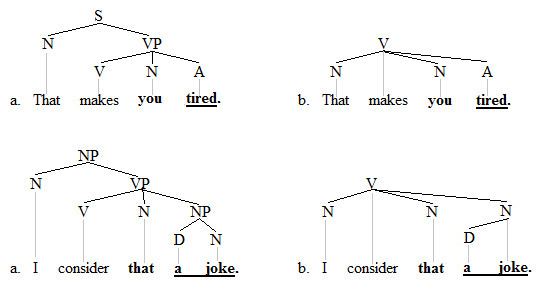 | ||
In linguistics, a small clause is a frequently occurring construction that has the semantic subject-predicate characteristics of a clause, but that lacks the tense of a finite clause and appears to lack the status of a constituent. The structural analyses of small clauses vary in part based upon whether a flat or layered analysis is pursued. The small clause is closely related to the phenomena of raising-to-object, exceptional case-marking, accusativus cum infinitivo, and even object control.
Contents
Examples
The following sentences contain (what some theories of syntax judge to be) small clauses. The actual small clause is in bold in each example:
In each of these sentences, the underlined expression functions as a predicate over the nominal immediately to its left. The verbs that license small clauses like these are a heterogeneous bunch. So-called raising-to-object or ECM verbs like consider and want license small clauses, and verbs like call and name, which subcategorize for an object NP and a predicative expression, also license small clauses. And verbs like wipe and pound, which allow the appearance of a resultative expression, can also be seen as allowing small clauses. One should note that what does and does not qualify as a small clause varies in the literature. Early discussions of small clauses were limited to the ECM-verbs like consider.
An important trait that all six examples above have in common is that the small clause lacks a verb. Indeed, this has been taken as a defining aspect of small clauses, i.e. to qualify as a small clause, a verb must be absent. If, however, one allows a small clause to contain a verb, then the following sentences can also be interpreted as containing small clauses:
The similarity across the sentences a-f and these four sentences g-j is obvious, since the same subject-predicate relationship is present in all ten sentences. Hence if one interprets sentences a-f as containing small clauses, one can also judge sentences g-j as containing small clauses. A defining characteristic of all ten of the small clauses in a-j is that the tense associated with finite clauses, which contain a finite verb, is absent.
Structural analysis
Broadly speaking, there are two competing analyses of the structure of small clauses, flat vs. layered. The flat analysis judges the subject and predicate of the small clause to be sister constituents, whereas the layered analysis takes them to form a single constituent. These two competing analyses are illustrated here. Both constituency-based structures of a phrase structure grammar and dependency-based structures of a dependency grammar are produced in the illustration. The flat analysis is given first:
The a-trees on the left are the phrase structure trees, and the b-trees on the right are the dependency trees. The key aspect of these structures is that the small clause material consists of two separate sister constituents. The layered analysis is given next:
The phrase structure trees are again on the left, and the dependency trees on the right. To mark the small clause in the phrase structure trees, the node label SC is used. The main difference between these layered trees and the flat trees further above resides with the status of the small clause as a constituent or not. The layered analysis is preferred by those working in the Government and Binding framework and its tradition, whereas the flat analysis is preferred by those working in dependency grammars and representational phrase structure grammars (e.g. Generalized Phrase Structure Grammar and Head-Driven Phrase structure Grammar).
Empirical considerations
There are a number of considerations that support or refute the one or the other analysis. The layered analysis, which, again, views the small clause as a constituent, is supported by the basic insight that the small clause functions as a single semantic unit, i.e. as a clause consisting of a subject and a predicate. The layered analysis is also supported by the fact that in certain cases, a small clause can function as the subject of the greater clause, e.g.
Most theories of syntax judge subjects to be single constituents, hence the small clauses Bill behind the wheel and Sam drunk here should each be construed as one constituent. Further, small clauses can appear as the complement of with, e.g.:
These data are also easier to accommodate if the small clause is a constituent.
One can argue, however, that small clauses in subject position and as the complement of with are fundamentally different from small clauses in object position. The data further above have the small clause following the matrix verb, whereby the subject of the small clause is also the object of the matrix clause. In such cases, the matrix verb appears to be subcategorizing for its object noun (phrase), which then functions as the subject of the small clause. In this regard, there are a number of observations suggesting that the object/subject noun phrase is a direct dependent of the matrix verb, which means the flat structure is correct: the small clause generally does not behave as a single constituent with respect to constituency tests; the object becomes the subject of the corresponding passive sentence; and when the object is a reflexive pronoun, it is coindexed with the matrix subject:
These data are consistent with the flat analysis of small clauses. The object of the matrix clause plays a dual role insofar as it is also the subject of the embedded predicate.
